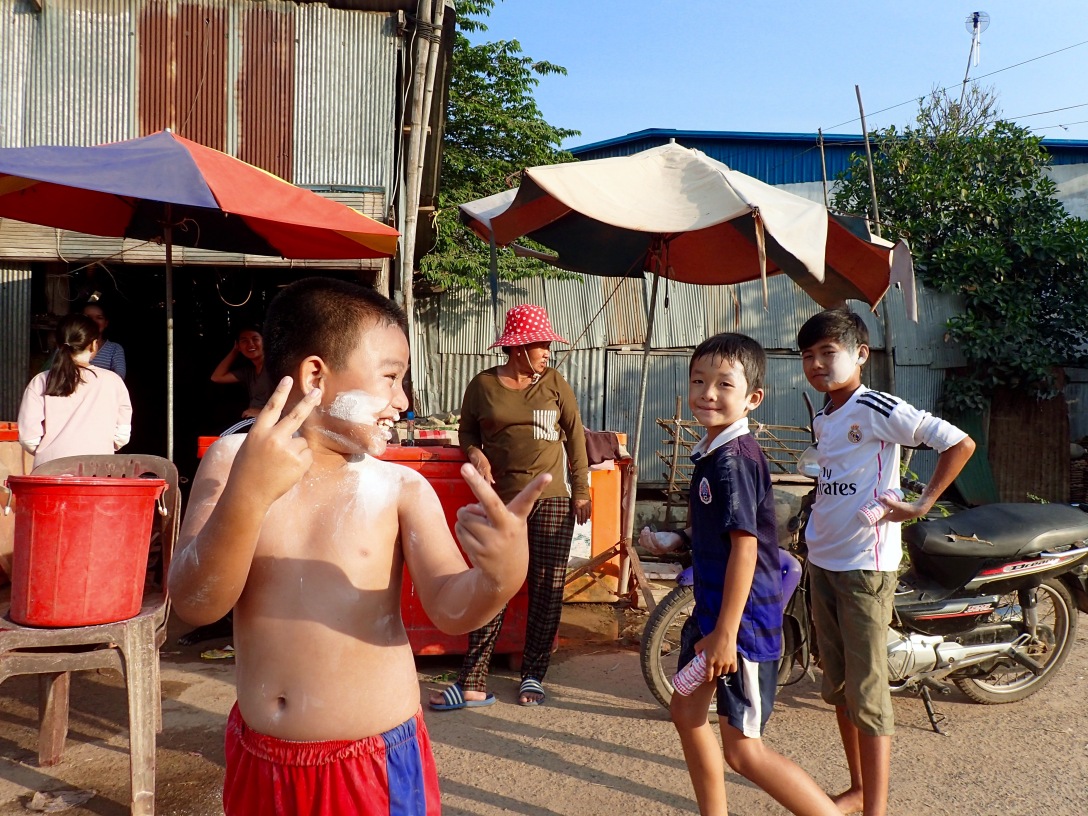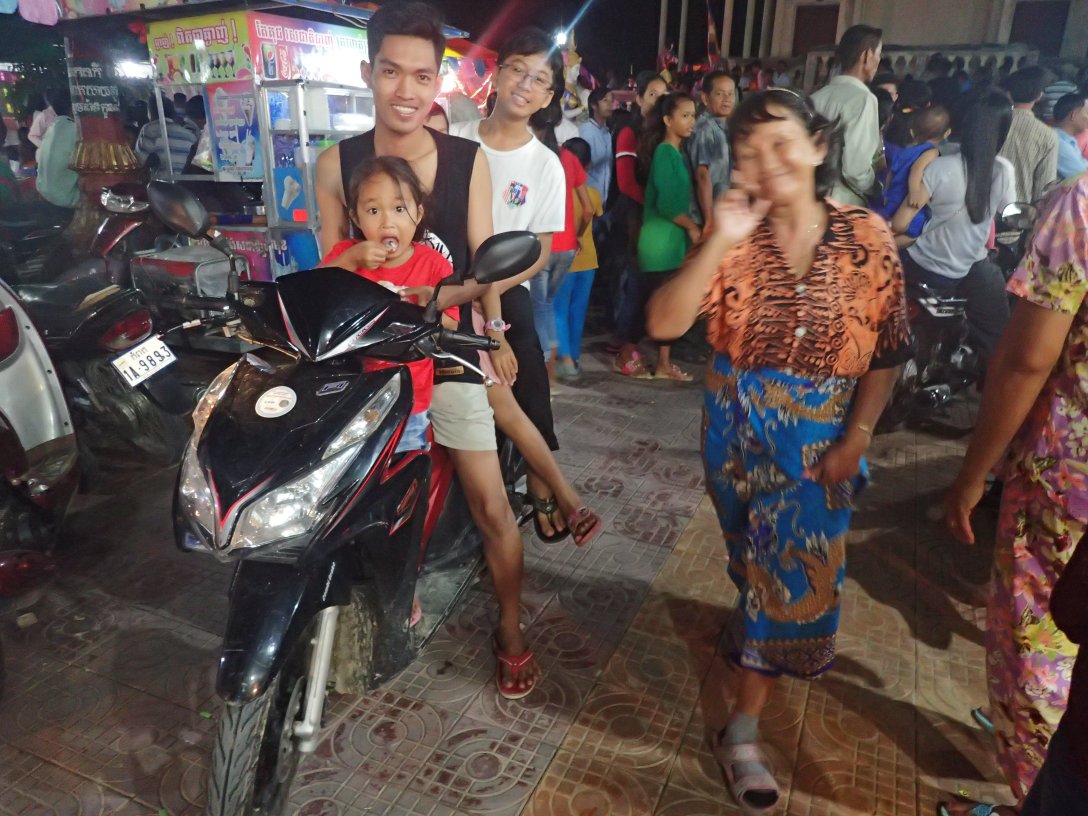Dear Grampa,
Last week all of Cambodia strutted splendidly into its two-thousandth five-hundredth and sixty-first year, the year of the Rooster. The mystical and ancient nature of the Khmer lunar calendar which dictates this, the end-all-be-all of Cambodian holidays, is such that a nationwide-effort to party harder than ever before must be made over the course of three days to entice that final, thrilling calendar page to yield from its binding. It plays out every year in April when the rice fields are ready for harvest, the heat is at its peak, and farmers want to relax and kick back before rainy season begins. All told, though, the three official days came after the five preceding weeks in which anticipation for the coming vacation prevented anything resembling scholarship from taking place in any local classroom. Before that were seven additional months wherein my marvel at various Khmer festivals and parties was met by exhortations that I “just wait for Khmer New Year,” they smiled slyly. “Just you wait.”
****************************************
After a brief vacation, I biked back into town on the evening of the first day of celebrations, Moha Sangkran, in which all the best efforts are made to welcome new spirits to enter the home and replace last year’s spirits. Many elderly Khmer still believe that the spirits which come on this day will reside in the home and the lives of their family for the entire year. Thus, you want to angle for the most generous and benevolent spirits you can muster up. Every house is the village looked spotless down to the pruned trees and neatly piled machine parts out front. Each family prepared an ornate table of fruit, flowers, candles, and other offerings (i.e. fancy orange Thai soda, men’s cologne, etc.) to act as a well-lit guardian-angel runway. Many of them twinkled into the night like Christmas trees.


That night and for 96 hours afterwards, blaring dance music alternating with Buddhist chanting emanated from the pagoda day and night. Combined with the personal, equally audible speakers being put to use in each and every home throughout town a regular cacophony of overall hootenanny was achieved. Such chaos has proven customary surrounding a Khmer holiday, but this time around even the nearly deaf grandmothers in town had choice words about the sheer volume and persistence of the hubbub. This made many amateur disc jockeys swell with pride in between their tenacious cultivation of atmospheric mischief. To keep things lively, kids and teens armed themselves with baby powder and plastic bags full of water to be tossed on unsuspecting victims. I attempted (and failed) to avoid such bamboozlement as I followed the hullabaloo to the pagoda where a traditional game was being played. Veay ko-orm is a piñata-like game involving blindfolds, being spun around, and taking desperate whacks at clay pots filled with powder and candies.


On the second day of celebrations, Virak Wanabat, gifts are given to elderly family members and charitable donations are made. I gathered with my coworkers at the health center to clean and welcome some of the monks from our local pagoda to bless the health center for the coming year. The younger of the two visiting venerable men is an English student of mine who reminded me to, “Smile be new year!” before flinging holy water in to my eyes.


Traditionally, younger family members will perform a ritual of washing their elders as a sign of reverence and a desire to absorb some of their wisdom, although this sadly did not play out in our village. There was no time to be disappointed about the lack of elder-washing, however, given the countless gatherings ranging in size and intensity from which to choose. I enjoyed a dozen or so rounds of a Vietnamese gambling game with an aunty and her visiting granddaughter (they were betting no more than about $0.05 at a time, so it’s fine…?) while we munched on fresh fruit. I also skated flippantly between a half-dozen other close-calls with uncles clustered and entrenched in beer, heavy from food, and yet still vocally dumfounded about my inexplicable opposition to a Khmer husband.



The third and final day, Tngay Lueng Saka, is the official first day of the new calendar year. I was told to expect ceremonious bathing practices to be performed upon decadent effigies of Buddha and extensive activities to be held at the pagoda, but found most the day to be remarkably ordinary. Then 5 PM came along and all hell broke loose. As I casually strolled through our front gate to go finish my humdrum taxes, an aunty calmly told me to “wait a moment, wait for the monks.” And then they arrived, with Buddha in tow.

Soon a fleet of many of the younger village men marched down the street – their faces made filthy with mud – to join the procession of chanting monks carting a small Buddha statue down the main drag. Families and hordes of incensed neighborhood kids crouched in huddles around 10-gallon buckets in front of their homes. Before I had time to wonder what was in the buckets, my 9-year old neighbor-niece yanked me down onto my haunches beside her and the rest of my neighbor aunties around their family’s bucket. My first goosebumps in months shot up my arms and back with the initial dousing of fresh holy water and the strident cadence of Buddhist recitations gurgled in and out of my ears between preceding bouts of the monk-facilitated water blessing. Soaked and elated I fended off my niece’s water-flicking fingers as I scrambled after the procession to capture as much as I could of the ceremonious showers.







Overwhelmed from so much sabbay (joy), I donned my coziest and therefore least flattering house clothes and settled in at my usual perch at the kitchen table, content to enjoy the distant pagoda clamor as I studied. In the middle of a routine pre-dinner shower came a knock at the door. It was aunty Srey Maec and she’d come to announce that the party was just beginning. I was dragged, damp and a little hangry, my protests unheard, stuffed with fancy beef and hot pot veggies, and thrown into the madness at the pagoda. I expected a festival with all the usual bells and whistles. What I didn’t expect was the all-out dance party. The effort expended in those countless hours of pre-service training aimed to prepare us for the chaste, delicate, shy, indirect, reverential nature of Khmer women and some men were shattered in that first bass-drop when everyone and their grandmother dropped it real low. The skilled DJ alternated between traditional “slow” songs customary for the circular progression Khmer dancing and modern favorites with more oomph!




I could only stand agape for so long. An arm soon shot out of the throng and, accompanied by excited shrieks of welcoming, I found myself dancing amid my tailor, her toddler, her the two brothers most famous for their flower-arrangement and wedding hair/make-up, the police chief, my tutor’s brother, a half dozen grandmothers I’d never met but grabbed my butt as if they’d birthed me themselves, and about one million of the students from the primary and high schools, all of whom had the mercy not to comment on my sweat-soaked, half-showered linen get-up. We were all flashy teeth and jangly jewelry and hair sticking to our hot temples. One of my favorite uncles, Om Sraom, appeared by my side during one the traditional slower dances. Despite hands unsteady from deep laughter and ambient bass, he captured one of the single most sweaty, wholesome, nourishing moments a foreign girl has spent in Cambodia in all it’s 2561 lunar years of sabbay.
 Grampa, I hope Easter proves as rambunctious and that you eat plenty of chocolate bunnies. If this all sounds too exciting, don’t worry (too much). I’ll ensure that things definitely won’t be quite as deafening by the time you visit, but I can’t promise there won’t be any impromptu shenanigans given that every day here convinces me that I will never know what is going on any more than half of the time.
Grampa, I hope Easter proves as rambunctious and that you eat plenty of chocolate bunnies. If this all sounds too exciting, don’t worry (too much). I’ll ensure that things definitely won’t be quite as deafening by the time you visit, but I can’t promise there won’t be any impromptu shenanigans given that every day here convinces me that I will never know what is going on any more than half of the time.
Love you (all the time),
Kelsifer
3 thoughts on “Khmer New Year”